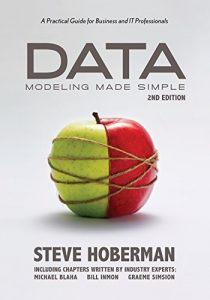practical working knowledge of data modeling concepts and best practices. This
book is written in a conversational style that encourages you to read it from
start to finish and master these ten objectives:
- Know when a data model is needed and which type of data model is most effective
for each situation - Read a data model of any size and complexity with the same confidence as reading
a book - Build a fully normalized relational data model, as well as an easily navigatable
dimensional model - Apply techniques to turn a logical data model into an efficient physical design
- Leverage several templates to make requirements gathering more efficient and
accurate - Explain all ten categories of the Data Model Scorecard
- Learn strategies to improve your working relationships with others
- Appreciate the impact unstructured data has, and will have, on our data modeling
deliverables - Learn basic UML concepts
- Put data modeling in context with XML, metadata, and agile development
This book begins like a Dan Brown novel. It even starts out
with the protagonist, our favorite data modeler, lost on a dark road somewhere
in France. In this case, what saves him isn't a cipher, but of all things,
something that's very much like a data model in the form of a map! The author
deems they are both way-finding tools.
The chapters in the book are divided into 5 sections. The chapters in each
section end with an exercise and a list of the key points covered to reinforce
what you've learned. I find myself comparing the teaching structure of the book
to the way most of us learn to swim.
SECTION I: Data Modeling Introduction
The first section is like the shallow end of the pool,
where as a beginning swimmer, you can dip your toes in to test the water. These
easy chapters are short and concise. Here the author uses very common objects to
describe what a data model is, and why it is so valuable. His first examples
made excellent use of what's truly a universal data model to millions of
computer users in school and business: the spreadsheet.
SECTION II: Data Model Components
In the second section, Steve Hoberman introduces you to the
simplest components that make up a data model, and explains the important terms
that we apply when we discuss them. By the end of section 2, you now have both
feet comfortably in the water. You're ready and eager to plunge deeper into the
depths of this pool of data model knowledge.
SECTION III: Subject Area, Logical, and Physical Data
Models
You've made it to the deep end of the pool where you get a
real workout as you lap through the 3 levels of data models: subject area (or
conceptual), logical, and physical. Just as there are different strokes for
different folks, there are different models for different audiences. By the end
of section 3, you'll be able to swim through the intricacies of a data model
like a barracuda.
SECTION IV: Data Modeling Quality
Just as swimmers can kick-start their movement through the
water with the use of swimming aids (maybe a flotation device or fins will
help), you can utilize Steve's 4 favorite templates to collect and organize the
requirements that will define your data model.
You may recall the scorecard
the Olympic judges use to rate a dive. Steve introduces his Data Model
Scorecard, which applies a quality rating to a data model. It's an
objective look at the quality of the model built. We are actually adopting this
tool where I work, after applying our own weightings to his 10 criteria.
SECTION V - Beyond Data Modeling
Believe it or not, you're ready to leave the pool and jump
head first into a small part of th






